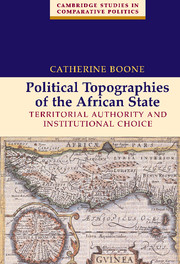Book contents
- Frontmatter
- Contents
- List of Maps, Tables, and Figures
- Preface and Acknowledgments
- 1 INTRODUCTION
- 2 MAPPING POLITICAL TOPOGRAPHY IN AFRICA
- 3 UNEVEN INSTITUTIONAL TOPOGRAPHY WITHIN ONE STATE
- 4 TAXING RICH PEASANTS: REGIME IDEOLOGY AS STRATEGY
- 5 THE GEOPOLITICS OF LATE DEVELOPMENT
- 6 CONCLUSION
- Appendix: A Note on Sources, Evidence, and Measurement
- References
- Index
- Cambridge Studies in Comparative Politics
Preface and Acknowledgments
Published online by Cambridge University Press: 26 December 2009
- Frontmatter
- Contents
- List of Maps, Tables, and Figures
- Preface and Acknowledgments
- 1 INTRODUCTION
- 2 MAPPING POLITICAL TOPOGRAPHY IN AFRICA
- 3 UNEVEN INSTITUTIONAL TOPOGRAPHY WITHIN ONE STATE
- 4 TAXING RICH PEASANTS: REGIME IDEOLOGY AS STRATEGY
- 5 THE GEOPOLITICS OF LATE DEVELOPMENT
- 6 CONCLUSION
- Appendix: A Note on Sources, Evidence, and Measurement
- References
- Index
- Cambridge Studies in Comparative Politics
Summary
Barrington Moore Jr. wrote that in modernizing Europe, methods of extracting the agricultural surplus formed the core of nearly all social and political problems. In studying rural marketing circuits and land tenure politics in Senegal and Côte d'Ivoire, I gradually realized the salience of this point for Africa, where general forms of the postcolonial state and political trajectories are usually seen as largely autonomous from the main currents of constancy and change in agrarian society. Modern African states have been understood as “bureaucratic states” or “postcolonial states,” but rarely as the agrarian states that they (also) are. This book adopts this perspective to rethink some key issues of state formation, territorial integration, and institutional development in modern Africa.
The main argument is that social forces have gone far in shaping and constraining patterns of state formation since the end of the nineteenth century, but that the full significance and implications of this are only revealed through development of appropriate spatial and temporal frames of analysis. We depart from much earlier work by highlighting the existence of geographically uneven patterns of state building within any given country; these uneven patterns are the “political topographies” referred to in the title. How and to what extent agrarian societies in Africa have been incorporated into the modern state are outcomes that have been determined by center-periphery struggles that are themselves shaped by local political facts.
- Type
- Chapter
- Information
- Political Topographies of the African StateTerritorial Authority and Institutional Choice, pp. xi - xivPublisher: Cambridge University PressPrint publication year: 2003

